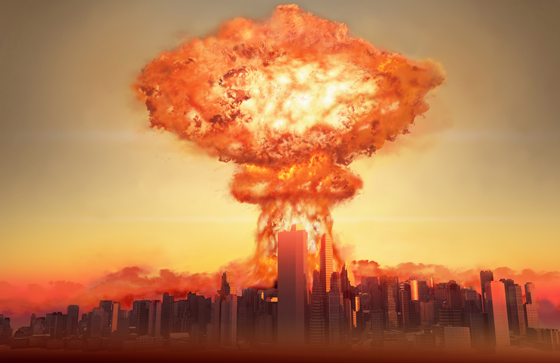This article was originally published by Ava Grace at Natural News.
-
- China is rapidly expanding its nuclear arsenal (projected to exceed 1,000 warheads by 2030) and developing advanced capabilities like hypersonic missiles and a full nuclear triad, shifting from “minimum deterrence” to strategic dominance in Asia.
-
- Beijing aims to undermine U.S. alliances by sowing doubt over America’s willingness to defend partners (e.g., Japan, South Korea, the Philippines) in a nuclear conflict, pressuring them into strategic passivity.
-
- Investments in hypersonic missiles, Fractional Orbital Bombardment Systems (FOBS), and mobile launchers ensure a survivable second-strike capability, enabling coercion without direct conflict.
-
- China exploits regional anxieties – pressuring Japan on Taiwan, threatening the Philippines over U.S. missile deployments, and keeping South Korea focused on North Korea – to isolate U.S. influence.
-
- The U.S. is urged to strengthen allied conventional forces, expose China’s coercive tactics, and prevent nuclear blackmail. Inaction could irreversibly shift power in Beijing’s favor.
According to a report by the Hudson Institute, China is no longer satisfied with merely deterring its adversaries. It is now aggressively expanding its nuclear arsenal to rival that of the U.S., with the ultimate goal of dominating Asia by the mid-2030s.
According to the report, Beijing’s rapid nuclear buildup is not solely for defensive purposes but is part of a broader strategy to undermine American influence in the region. By amassing over 1,000 warheads, establishing a full nuclear triad (land, sea, and air-based missiles), and developing tactical nuclear weapons, China aims to sow doubt among U.S. allies, pressuring them into strategic inaction.
This shift represents a perilous new chapter in global security, where nuclear weapons are not just instruments of war but tools of political coercion. If left unchecked, China’s strategy could fracture U.S. alliances in Asia, embolden its territorial ambitions, and fundamentally alter the balance of power in the Indo-Pacific. (Related: China sends two aircraft carriers to the Pacific, signaling growing naval ambitions.)
For decades, China adhered to a doctrine of “minimum deterrence,” maintaining a modest nuclear arsenal sufficient to retaliate if attacked. However, under President Xi Jinping, Beijing has abandoned restraint.
The U.S. Department of Defense estimates that China currently possesses at least 600 warheads, with projections suggesting that number will surpass 1,000 by 2030. While still trailing the U.S. and Russia in sheer numbers, this expansion signifies a dramatic shift in China’s strategic posture.
China is not preparing for an all-out nuclear war. Instead, it seeks to exploit psychological and political vulnerabilities among U.S. allies. By fostering uncertainty over whether America would risk nuclear conflict to defend partners like Japan, South Korea or the Philippines, Beijing aims to erode trust in U.S. security guarantees. The Hudson Institute warns that this could lead to “strategic passivity” – allies hesitating to resist Chinese aggression out of fear of abandonment.
The think tank’s report identifies three key U.S. allies in Beijing’s sights:
-
- Japan, heavily reliant on the U.S. nuclear umbrella, faces a relentless Chinese information campaign aimed at weakening confidence in American commitments. Beijing seeks to make Tokyo hesitant in supporting U.S. operations, particularly in a potential Taiwan crisis.
-
- Philippines, embroiled in maritime disputes in the South China Sea, has faced subtle nuclear threats from China. These threats could escalate if Manila hosts U.S. missile systems capable of striking Chinese territory.
-
- South Korea, preoccupied with North Korea’s nuclear threat, has been reluctant to fully align with U.S. efforts against China. Beijing aims to keep Seoul disengaged from broader regional conflicts, further isolating America’s influence.
China’s nuclear rise and the future of Asia
China’s nuclear modernization is not merely about quantity – it is about capability. The country is investing in advanced technologies designed to evade missile defenses and strike with minimal warning.
Hypersonic missiles capable of maneuvering mid-flight present a formidable challenge to interception. Fractional Orbital Bombardment Systems (FOBS), a Cold War-era concept revived by China, involve launching warheads into low-Earth orbit before deorbiting them onto targets, bypassing traditional missile detection. Additionally, mobile launchers – road-mobile and submarine-based missiles – make preemptive strikes against China’s nuclear forces far more difficult.
These advancements ensure China has a “survivable second strike” capability, guaranteeing retaliation even after an enemy attack. More critically, they allow Beijing to intimidate U.S. allies without ever firing a shot.
The Cold War demonstrated that nuclear parity between superpowers can prevent direct conflict, but also embolden coercion and proxy wars. As China rises to become a nuclear peer of the U.S., the Indo-Pacific risks entering an era of heightened instability, where Beijing leverages its arsenal to intimidate neighbors and challenge American leadership.
Taiwan remains the most immediate flashpoint. If China believes the U.S. and its allies will hesitate to intervene due to nuclear risks, it may gamble on invasion. Similarly, nations like Vietnam and India could face intensified pressure to acquiesce to Chinese demands.
The report advocates a decisive response, noting that traditional arms control agreements are unlikely to work given China’s opacity. Instead, the U.S. must focus on maintaining military superiority. Strengthening conventional forces among allies will raise the cost of Chinese aggression, while publicly exposing Beijing’s coercive tactics could galvanize allied resolve.
“Washington and its allies must show that China’s buildup is backfiring – leading not to fear and passivity, but to renewed resolve and regional rearmament,” the report says.
The stakes could not be higher. If America fails to counter China’s nuclear strategy, the balance of power in Asia and the world will shift irreversibly in Beijing’s favor. The time to act is now.
Watch this Sky News Australia report about China criticizing the U.S. for “inciting tensions.”
This video is from the NewsClips channel on Brighteon.com.
Read the full article here




